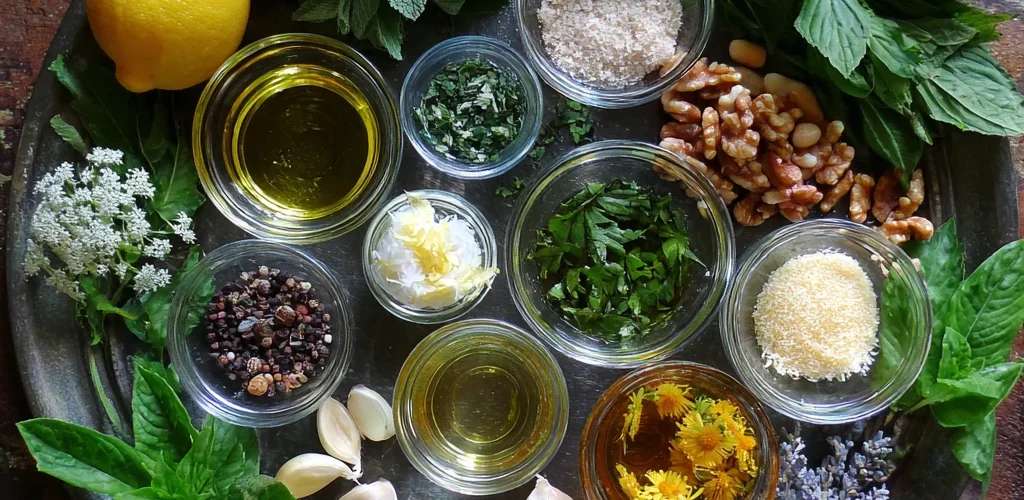Top 10 Creative Ways to Use Fresh Herbs
Fresh herbs aren’t just for sprinkling on your pasta or adding a finishing touch to your roasted chicken. They’re versatile flavor bombs that can elevate your cooking, home, and even your well-being. From culinary masterpieces to aromatic crafts, discover ten innovative ways to unlock the full potential of your garden’s bounty or your grocery store’s freshest offerings.
Section 1: Culinary Adventures with Fresh Herbs
Beyond simple garnishes, fresh herbs can be the star of the show in many dishes. Embrace their vibrant flavors and aromas to transform ordinary meals into extraordinary culinary experiences.
1. Herb-Infused Oils and Vinegars
Infusing oils and vinegars with fresh herbs is an easy way to add depth and complexity to your cooking. Simply combine your favorite herbs – rosemary, thyme, basil, or oregano work beautifully – with high-quality olive oil or vinegar in a sterilized jar. Let the mixture steep for a few weeks in a cool, dark place, and then strain before using. Herb-infused oils are fantastic for drizzling over salads, vegetables, or grilled meats, while herb-infused vinegars add a zesty kick to dressings and marinades. The possibilities are endless, so experiment with different combinations to find your favorites. For example, a rosemary-infused olive oil drizzled over roasted potatoes or focaccia is a simple yet incredibly flavorful treat. Or consider a basil-infused vinegar to brighten up a Caprese salad or tomato soup.
2. Herb Butters and Compound Butters
Elevate your everyday butter by creating herb butters and compound butters. Soften unsalted butter and mix it with finely chopped fresh herbs like chives, parsley, dill, or sage. You can also add garlic, lemon zest, or spices for extra flavor. Roll the butter into a log, wrap it in parchment paper, and refrigerate until firm. Herb butters are delicious on toast, grilled meats, fish, or vegetables. Imagine a dill butter melting over steamed asparagus or a sage butter enriching a pan-seared steak. Compound butters offer even more flavor complexity by incorporating additional ingredients like sun-dried tomatoes, olives, or roasted garlic.
3. Herb Pesto Variations
Pesto is a classic Italian sauce made with basil, pine nuts, garlic, Parmesan cheese, and olive oil. But don’t limit yourself to basil! Experiment with other herbs like cilantro, parsley, mint, or even arugula to create unique pesto variations. Cilantro pesto is fantastic with Mexican-inspired dishes, while mint pesto adds a refreshing twist to pasta or grilled lamb. Adjust the ingredients to suit your taste and create a pesto that’s all your own. Consider adding walnuts instead of pine nuts for a more affordable option, or substitute nutritional yeast for Parmesan cheese to make a vegan pesto.
4. Herb-Crusted Meats and Fish
Create a flavorful crust for meats and fish by combining finely chopped fresh herbs with breadcrumbs, Parmesan cheese, and olive oil. Press the mixture onto the surface of the protein and bake or pan-fry until golden brown and cooked through. Herb-crusted meats and fish are a delicious and impressive way to add flavor and texture to your meals. A rosemary and thyme crust on a roasted chicken is a classic combination, while a parsley and lemon crust on baked cod is a light and refreshing option.
5. Herb-Infused Simple Syrups
Simple syrups aren’t just for cocktails! Infusing them with fresh herbs can add a unique and delicious touch to your beverages and desserts. Combine equal parts water and sugar in a saucepan and bring to a simmer. Add your favorite herbs, such as mint, lavender, or rosemary, and let the mixture steep for about 30 minutes. Strain the syrup and store it in the refrigerator. Use herb-infused simple syrups to sweeten iced tea, lemonade, cocktails, or even drizzle over pancakes or waffles. A lavender simple syrup added to a glass of lemonade is incredibly refreshing on a hot summer day, while a rosemary simple syrup adds a subtle savory note to a gin and tonic.
Section 2: Aromatic Home Décor with Fresh Herbs
Fresh herbs aren’t just for the kitchen; they can also be used to create beautiful and fragrant home décor. Their natural aromas can uplift your mood and add a touch of freshness to any space.
6. Herbal Sachets and Potpourri
Create your own herbal sachets and potpourri to freshen up closets, drawers, and rooms. Combine dried herbs like lavender, rosemary, thyme, and mint with dried flowers, spices, and essential oils. Place the mixture in small cloth bags or decorative bowls to release the fragrance. Herbal sachets are perfect for tucking into drawers to keep clothes smelling fresh, while potpourri can add a touch of natural beauty to your living room or bathroom. Experiment with different combinations of herbs and spices to create your own signature scent. For example, a lavender and chamomile sachet is perfect for promoting relaxation, while a rosemary and citrus potpourri is invigorating and uplifting.
7. Herbal Wreaths and Garlands
Craft stunning herbal wreaths and garlands to decorate your home for any season. Use a grapevine wreath form or wire frame as a base and attach fresh or dried herbs with floral wire or glue. Add flowers, berries, or other natural elements for extra visual appeal. Herbal wreaths and garlands are a beautiful way to bring the outdoors in and add a touch of rustic charm to your décor. A rosemary wreath is perfect for the holidays, while a lavender garland is ideal for a summer garden party.
Section 3: Health and Wellness with Fresh Herbs
Many fresh herbs possess medicinal properties that can promote health and well-being. From soothing teas to invigorating bath soaks, discover how to incorporate herbs into your self-care routine.
8. Herbal Teas and Infusions
Brew your own herbal teas and infusions to enjoy the health benefits of fresh herbs. Simply steep a handful of fresh herbs like mint, chamomile, lemon balm, or ginger in hot water for 5-10 minutes. Strain the tea and enjoy it hot or cold. Herbal teas can help with digestion, relaxation, sleep, and overall well-being. Mint tea is a classic digestive aid, while chamomile tea is known for its calming properties. Experiment with different herbs and blends to find your perfect cup.
9. Herbal Bath Soaks and Scrubs
Create relaxing and rejuvenating herbal bath soaks and scrubs to pamper your skin and soothe your senses. Add fresh herbs like lavender, rosemary, or calendula to a warm bath along with Epsom salts or bath oils. You can also make your own herbal scrubs by combining finely chopped herbs with sugar, salt, or olive oil. Herbal bath soaks and scrubs can help to relieve stress, soothe sore muscles, and exfoliate the skin. A lavender bath soak is perfect for unwinding after a long day, while a rosemary and sea salt scrub can invigorate and energize your skin.
Section 4: Gardening and Propagation of Fresh Herbs
Growing your own fresh herbs is a rewarding experience that provides you with a constant supply of flavorful ingredients for your culinary creations and other projects.
10. Propagating Herbs from Cuttings
Extend your herb garden by propagating herbs from cuttings. Take stem cuttings from healthy plants and remove the lower leaves. Place the cuttings in water or moist potting mix and wait for roots to develop. Once the roots are established, transplant the cuttings into individual pots. Propagating herbs from cuttings is an easy and affordable way to expand your herb collection and share your plants with friends and family. Rosemary, mint, and basil are all easy to propagate from cuttings.
Section 5: Tips and Tricks for Using Fresh Herbs
To get the most out of your fresh herbs, follow these tips and tricks for storing, preparing, and using them in your cooking and other projects.
- Storing Fresh Herbs: Store fresh herbs in the refrigerator to keep them fresh longer. Wrap them in a damp paper towel or place them in a glass of water like flowers.
- Preparing Fresh Herbs: Wash fresh herbs thoroughly before using them. Remove any damaged or discolored leaves. Chop herbs finely for maximum flavor release.
- Using Fresh Herbs in Cooking: Add fresh herbs towards the end of cooking to preserve their flavor and aroma. Use generous amounts of fresh herbs for the best results.
- Drying Fresh Herbs: Preserve your herbs for later use by drying them. Hang them upside down in a cool, dry place or use a dehydrator.
- Freezing Fresh Herbs: Freeze fresh herbs to preserve their flavor and aroma. Chop them finely and mix them with olive oil or water before freezing in ice cube trays.
By incorporating these ten creative ways to use fresh herbs into your life, you can unlock their full potential and enjoy their many benefits. From enhancing your culinary creations to creating aromatic home décor and promoting health and well-being, fresh herbs are a versatile and valuable resource.
FAQ: Fresh Herbs
- How do you store fresh herbs to keep them fresh longer?
Wrap them in a damp paper towel or place them in a glass of water like flowers in the refrigerator.
- What are the best herbs to grow at home?
Basil, mint, rosemary, thyme, and parsley are easy to grow in pots or in the garden.
- How do you dry fresh herbs?
Hang them upside down in a cool, dry place or use a dehydrator.
- Can you freeze fresh herbs?
Yes, chop them finely and mix them with olive oil or water before freezing in ice cube trays.
- What are some good herbs for beginners?
Mint and chives are especially easy to grow and require minimal maintenance.
- What are the most popular fresh herbs?
Basil, parsley, cilantro, rosemary, and thyme are among the most commonly used fresh herbs.
- How often should I water my herb plants?
Water regularly, allowing the soil to dry slightly between waterings.
- What is the best way to chop fresh herbs?
Use a sharp knife and chop them finely for maximum flavor release.



